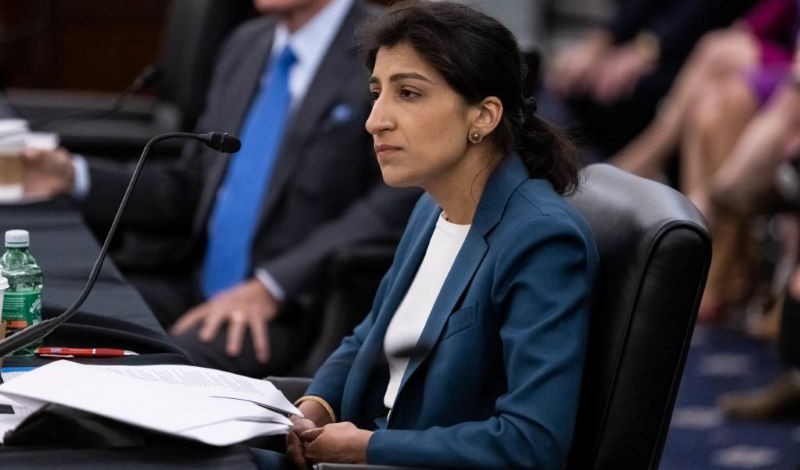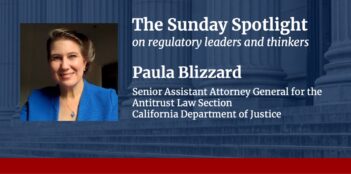
The shift by agencies away from the current guidelines on mergers and acquisitions has left firms in limbo.
The Sherman and Clayton Antitrust Acts are so broadly worded that they can support a wide range of interpretations. The agencies charged with implementing the statutes—the Federal Trade Commission (FTC) and the Antitrust Division of the U.S. Department of Justice—do not have the power to issue substantive rules to implement them. They do have the power, however, to issue interpretive rules and statements of general policy to provide guidance on how they will interpret and apply the statutes.
The FTC and the Justice Department have exercised that power for decades by issuing joint guidelines that describe how the agencies will interpret and apply the Sherman and Clayton Acts. Those guidelines have been extraordinarily important in many contexts. For example, they enable firms to determine when and how they can engage in joint ventures that are intended to further their mutual goals in conducting research and development and by enabling healthcare providers to identify the circumstances in which they can consolidate their operations by creating accountable care organizations under the Affordable Care Act.
The most important guidelines concern mergers and acquisitions. In 1976, Congress enacted the Hart-Scott-Rodino Act (HSR), which created a new system for determining whether a proposed merger or acquisition violates the Clayton Act and, in particular, its Section 7.
Under the HSR, a firm that intends to merge with or acquire another firm must make a filing with the Justice Department and the FTC at least 30 days before the date of the proposed merger or acquisition. The Justice Department and the FTC meet periodically to allocate responsibility to implement the HSR between the agencies by sector of the economy. The agencies have 30 days in which to decide whether the proposed transaction would violate the Clayton Act. The statute authorizes extensions of the decisional deadline up to 30 days, but the parties to the proposed transaction often acquiesce in much longer extensions of the decisional deadline when the Justice Department or the FTC ask for additional time to evaluate a proposed transaction.
The HSR created a system of agency adjudication that is unlike any other. In all other contexts, an agency adjudication closely resembles a trial. The agency provides notice of its position and the reasons why it believes that a firm is violating the law. The firm then has an opportunity to respond. The agency and the firm then present their conflicting evidence in a hearing conducted by an administrative law judge (ALJ). The parties then file briefs, and the ALJ issues an opinion in which she explains her decision. Either party can then appeal to the head of the agency. After considering the briefs of the parties on appeal, the agency head can either adopt the decision and reasoning of the ALJ or replace it with the agency’s contrary decision, along with a statement of the agency’s reasoning in support of its decision.
Each step in the normal process of agency adjudication is completely transparent. Every firm that is potentially affected by the agency’s decision and every potentially affected member of the public has complete access to court documents such as the pleadings, the relevant evidence, and the ALJ’s decision-making process.
The HSR system of agency adjudication of disputes dealing with the legality of a proposed merger or acquisition differs completely from the normal system of agency adjudication. Every step in the HSR decision-making process takes place behind closed doors. The process is completely opaque. The public has no way of knowing what transpired, except in the rare case in which the firm that proposes to engage in the transaction decides to complete the transaction after the agency has notified the firm of its decision that the transaction is illegal. In those few cases, the ensuing litigation creates a public record that provides the public with a window into the agency decision-making process that gave rise to the litigation.
Such opacity is particularly problematic because of the dearth of legal precedent which could determine the boundaries of the broad discretion that the agencies have in interpreting and applying Section 7 of the Clayton Act. But the U.S. Supreme Court has not issued any decision interpreting and applying Section 7 in 50 years, and major changes in the Court’s approach to antitrust law during that time render the Court’s old decisions of little value in predicting how the Court would interpret Section 7 today.
Thus, the merger guidelines issued by the Justice Department and the FTC have provided much-needed transparency to the HSR decision-making process. The guidelines are extremely detailed. They describe every step that the agency takes in the process of deciding whether a proposed transaction has the potential to reduce consumer welfare by reducing competition between firms in a market. Reduced competition harms consumers because it allows firms to raise prices and reduce the quality and availability of goods and services.
The guidelines have served two valuable purposes.
First, they allow firms to predict with a high degree of confidence which of three actions the agencies will take with respect to a transaction the firm is considering. The FTC or the Justice Department determine that most of the thousands of proposed transactions are unlikely to have adverse effects on competition. In those cases, the agency has quickly terminated the review process and notified the firm of its decision to acquiesce in the transaction.
In a much smaller number of cases, the agency has notified the firm that it needs additional data and must engage in detailed analysis of the proposed transaction to determine whether it is likely to have an adverse effect on competition.
In some fraction of those cases, the agency determined that the transaction is likely to have an adverse effect on competition and notified the firm that it will seek an injunction—a court order—to preclude the firm from completing the proposed transaction if the firm decides to attempt to complete the transaction notwithstanding the agency’s determination that it would violate Section 7 of the Clayton Act. Until recently, the FTC prevailed in most of the cases in which it sought to stop a transaction that it found to be a violation of Section 7.
Second, the guidelines provide a detailed description of the data that a firm must collect and the analyses that the firm must complete for submission to the agencies to allow them to decide whether to acquiesce in the transaction, to engage in a more detailed analysis of the transaction, or to disapprove of the transaction.
The FTC and Justice Department’s system of agency adjudication worked reasonably well until Lina Khan became Chair of the FTC and Jonathan Kanter became Assistant Attorney General for Antitrust. In January 2022, they announced their intent to publish new guidelines that would significantly reduce the number of permissible mergers. Khan and Kanter have not yet taken that action, but their announcement has already affected firms.
Khan has made it clear that she disagrees with every characteristic of the prior guidelines, including the guidelines’ goals. She rejects the goal of maximizing consumer welfare, which the Justice Department and the FTC have pursued for the last 50 years. Instead, she has emphasized the need to protect competitors from large firms that charge low prices—a goal that the enforcement agencies and the Supreme Court disavowed 50 years ago. Khan cannot further her stated goals by applying the 2010 guidelines.
Khan’s policy goals raise a critically important question. How does the FTC interpret Section 7 of the Clayton Act under Khan’s leadership and what analytical steps will the FTC take to determine whether a proposed transaction is legal?
Professor Daniel Sokol led a team of researchers that attempted to answer those questions by interviewing the lawyers and economists who advise firms that are considering whether to propose a merger or acquisition. The findings of the Sokol study are disturbing. The experts on the HSR process can tell that the agencies are no longer acting in ways that are consistent with the guidelines, but they have no idea what criteria or analytical tools the agencies are applying in that process. They are particularly mystified by the FTC’s actions.
As a result of the massive confusion and wide range of uncertainty with respect to the FTC’s goals and decision-making criteria and the complete opacity of the HSR decision-making process, lawyers and economists are unable to provide informed advice to firms that are considering whether to merge or to acquire another firm. They cannot predict whether the FTC will disapprove of a proposed transaction. They cannot identify the criteria and analytical techniques that the FTC will use to make that decision. And they cannot tell a firm what data and analyses the firm must submit to allow the FTC to make that decision.
The appalling situation facing firms raises another question. Why is the FTC providing no guidance about how it will assess the legality of proposed mergers and acquisitions?
The head of the Center for the Study of the Administrative State, Adam White, told me that he believes that the FTC under Khan’s leadership has decided that it is best served by maximizing uncertainty about antitrust laws. That is a plausible partial explanation, particularly in circumstances in which the FTC’s new views conflict with the longstanding views of the Supreme Court.
I argue, however, that the FTC is also motivated by fear of the likely judicial reaction to a new set of guidelines that reflect the actual criteria that Khan is attempting to apply in the HSR decision-making process.
In 2010, the FTC and Justice Department issued the most recent guidelines for horizontal mergers, which are mergers between two firms operating as competitors in the same market. At that time, the law governing judicial review—the process by which a court can declare agency action unlawful—was simple. Because interpretative rules and statements of general policy are not legally binding, they were not subject to judicial review under the legal precedent existing at that time.
That administrative law doctrine has changed completely.
In 2012 and 2016, the Supreme Court issued two unanimous opinions in which it instructed lower courts to engage in review of many agency actions at the earliest possible time. The Court expressed concern that individuals and firms adversely affected by unlawful agency actions were only able to obtain judicial review after a long and expensive agency decision-making process.
Federal appellate courts have responded to those opinions by changing their methods of determining whether and when an agency action is reviewable. Courts now apply to interpretative rules and general statements of policy the same two-part test that the Supreme Court announced as applicable to substantive rules in its famous 1967 opinion in Abbott Laboratories v. Gardner. An interpretative rule or general statement of policy is subject to immediate pre-application judicial review if it raises an issue that a court can address without knowing the facts of any particular case and if a delay in addressing the question would create hardship to the petitioner in the form of delay or cost before a court otherwise could address the issue.
Any new merger guidelines that reflect Khan’s views on antitrust law would be highly likely to satisfy the two-part test and be subject to immediate judicial pre-application review. The guidelines would have no chance of surviving the review process since Khan’s views differ dramatically from the views of the Supreme Court.
In addition, a more recent change in administrative law doctrine would doom the guidelines before the FTC could apply them in any case. When I published the sixth edition of the Administrative Law Treatise that I co-author, I characterized temporary injunctions with respect to major agency actions as “rare.” The seventh edition that will be published in a few months will characterize nationwide preliminary injunctions as “routine.” Courts now regularly stop agencies from implementing an action when they make an initial determination that the action is illegal.
What should firms do when the FTC and the Justice Department refuse to issue new guidelines that reflect the reality of their methods of implementing the HSR decision-making process?
My advice is simple. Firms should use the 2010 guidelines as the basis for deciding whether to propose a merger or acquisition. They should refuse to acquiesce in any agency request to extend the decision-making deadline beyond 60 days. They should close the transaction at the end of the 60-day decision-making period even if the Justice Department or the FTC determine that the transaction violates Section 7 of the Clayton Act. They should then litigate the issue in court.
Given the complete disconnect between the views of the current leaders of the enforcement agencies and the courts, any firm that follows that path is highly likely to prevail in court. The FTC’s history of success in opposing proposed transactions in court has been replaced by a string of defeats under Khan.




